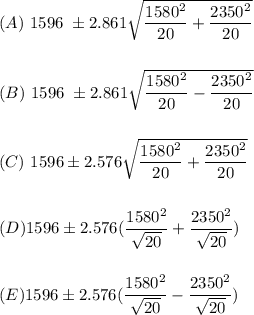
Mathematics, 11.06.2020 02:57, silvajimena74
The manufacturer of a smart watch claims that individuals who pay attention to how many steps they take per day will inadvertently take more steps per day than individuals who pay no attention to how many steps they take per day. To investigate this claim, the manufacturer conducts a study to estimate the difference in the mean number of steps taken by those that pay attention to how many steps they take per day and those that do not. To do so, 40 volunteers are recruited. Half of the volunteers are randomly assigned to receive a smart watch and are taught how to use it to track their steps. The other half of the volunteers are given a wristband to wear, but are not informed that the wristband is tracking their steps. The volunteers are monitored for 30 days. The mean and standard deviation of the number of steps taken per day are computed for each group. Here are the data:
Payti
Do not pay itin 01 0 10 20 87 64 82 350
Which of the following is a 99% confidence interval for the difference in the mean number of steps taken by all people like these that do and do not pay attention to the number of steps they take per day using df - 192
(A) 1596 + 2.861/15802 + 23502
(B) 1596 +2.861, 15.302 – 23502
(C) 1596 +2.576,15802 + 23502
(D) 1596 + 2.576 ( 15802 + 23502) °
(E) 1596 + 2.576 ( 15892 – 23502)

Answers: 2
Other questions on the subject: Mathematics

Mathematics, 21.06.2019 15:30, RyannLambertt9722
What is the missing reason in step 5? linear pair postulategivendefinition of complementary anglescongruent complements theorem
Answers: 1

Mathematics, 21.06.2019 18:00, aleilyg2005
List the sides of δrst in in ascending order (shortest to longest) if: m∠r =x+28°, m∠s = 2x+16°, and m∠t = x+12°
Answers: 1

Mathematics, 21.06.2019 19:40, marshallmattah
Suppose that 3% of all athletes are using the endurance-enhancing hormone epo (you should be able to simply compute the percentage of all athletes that are not using epo). for our purposes, a “positive” test result is one that indicates presence of epo in an athlete’s bloodstream. the probability of a positive result, given the presence of epo is .99. the probability of a negative result, when epo is not present, is .90. what is the probability that a randomly selected athlete tests positive for epo? 0.0297
Answers: 1

Mathematics, 21.06.2019 23:30, jailinealvarado24
Simplify. 3(4+4x) (type your answer in with no spaces)
Answers: 1
Do you know the correct answer?
The manufacturer of a smart watch claims that individuals who pay attention to how many steps they t...
Questions in other subjects:





Mathematics, 29.10.2020 17:00



















